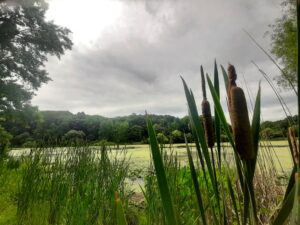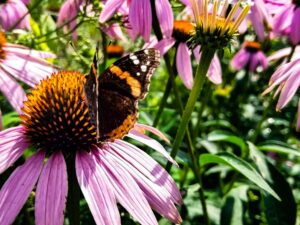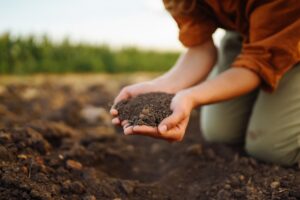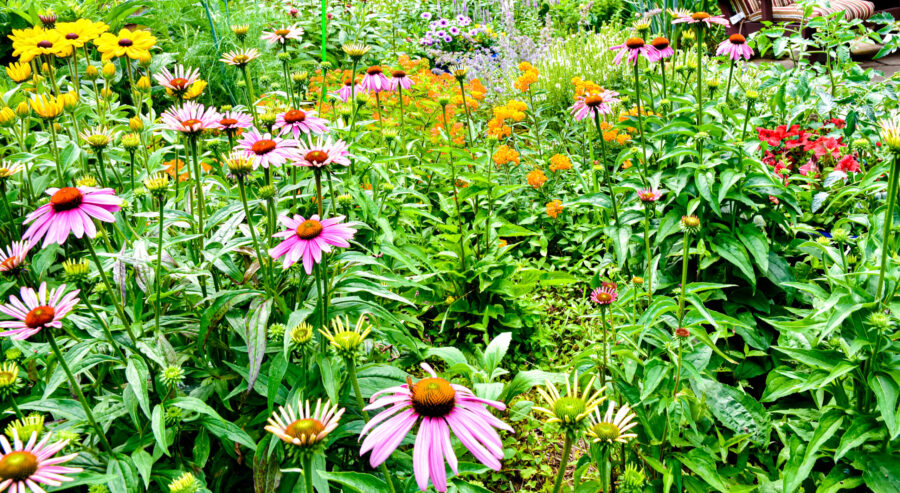If you’ve ventured into the gardening world recently, there’s a chance you’ve heard a popular buzzword: biodiversity. You may know that it’s important to nature and even what it means! You may know it from science class or simply by having a good handle of the English language.
No matter how you know it and what you know about it, in this article, we are taking a deep dive into all things biodiversity!
What is Biodiversity?

First off, if you’re planning to help foster biodiversity in your garden, it’s important to know just what it is! In simple terms, biodiversity is the diversity of life within an ecosystem. That involves more than just how many plants you choose to grow in your landscape; biodiversity must involve all living things, from plants and fungi to animals and microscopic organisms.
Similar to the natural presence of native plants, the concept of biodiversity is highly specific to a given area. In one spot containing a pond, lots of tree coverage, and rocky soils, the diversity of life might include mosses, lichen, ferns, frogs, ducks, fish, and even pesky mosquitoes, not to mention the thousands of microorganisms that call the pond home. Typically, the biodiversity in these ecosystems is very high!
In a totally different landscape featuring dry, sandy soil, little to no tree coverage, and hot desert temperatures, life becomes a lot less diverse; you may find a cactus here and a hawk there, but there are also millions of microbes you cannot see with the naked eye, some of which hold the sand together in strands like those discovered in the Sonoran Desert.
Suffice to say, biodiversity is highly variable in any given place, but why is it so important and what can you do to help foster it? That’s exactly what we’re going to talk about next!
Benefits of Biodiversity

There are many benefits of biodiversity in any given space. Afterall, a diverse and interconnected landscape is how ecosystems naturally form.
Strengthens Nature
Above all else, biodiversity helps strengthen nature and everything that interacts with it, including humans! By having a varied accumulation of species, ecosystems are able to protect themselves from dying off if one plant, animal, microorganism, fungi, or any other living thing can no longer support the others. Just as you would never serve just one dish at a Thanksgiving meal, nature should not be expected to sustain itself off of just one species.
Ever heard of the Irish potato famine? That’s a great example of the dangers of monoculture, or the lack of plant biodiversity. The reason that the horrific famine occurred was due to the production of one crop, potatoes, specifically the dependence on the “Irish Lumper” potato, for all of Ireland’s food. Once this potato was infected with the fungus Phytophthora infestans, every single crop was sure to fail. If farmers had grown multiple types of potatoes, some of which wouldn’t have been susceptible to this fungus, many people who perished may have lived to tell the tale.
Varied Resources for Human Use
Other benefits of biodiversity include allowing a wider variety of resources – like food, medicine, textiles, building materials, and more – to be used by humans, ensuring the sustainability of our modern civilization. This, in turn, will allow for the formation and strengthening of soil structure, the enhanced cleansing of our water sources, and the expanded beauty of our world. Imagine looking out your window only to see one type of tree or one type of animal? That sounds pretty dull, if you ask us.
Benefits Human Health
Health is paramount, especially in our modern society. A vital component of maintaining health is biodiversity. Much like the intricate ecosystem within the human body, filled with diverse microorganisms such as bacteria, fungi, and viruses, each playing a role in sustaining health, disruptions in this delicate balance can lead to adverse effects.
Similarly, natural landscapes flourish with an abundance of life, characterized by genetic diversity, species richness, and varied ecosystems. Incorporating this diversity into environments enhances their overall health, consequently improving human well-being. Cleaner water, purer air, and more nutritious food are among the benefits of fostering biodiversity, underscoring the interconnectedness between ecosystem health and human health.
Threats to Biodiversity

Sadly, there are a great deal of threats to our world’s natural biodiversity, many of which have been worsened or even caused by human actions.
Monoculture
As previously stated, one such threat is the elimination of an entire food source, like the Irish Lumper potato. This same concept carries itself into any avenue of the natural world. If you only grow one type of plant in your garden, how can you expect a variety of species that normally depend on its resources to be sustained?
One of the worst examples of this issue in our country is the existence of the manicured lawn. Naturally, the land on which homeowners, golf courses, and other lawn-growers maintain their monoculture grass would have a wide variety of plants flourishing on them. From herbaceous perennials to shrubs and even to non-invasive weeds, that land is accustomed to a healthy balance of species. Once you remove those species, adding instead an introduced, non-native grass, you eliminate the chance for animals, microscopic organisms, and other plants to thrive off that land, thereby reducing healthy biodiversity. This, in turn, may reduce the number of pollinators coming to your backyard garden or simply tank the quality of your soil. And, we’re not even going to get into how most lawn-growers treat the lawns, using immense amounts of water and harsh, leaching chemicals.
Pollution
Of course, chemicals and pollutants in the air, water, and soil are also threats to our Earth’s biodiversity. The burning of fossil fuels into the atmosphere, the dumping of waste products into the oceans, and the pumping of pesticides into the land all aid in the decimation of thousands of species. Once that happens, biodiversity is instantly decreased, as thousands more species who depended on them will also die off. Furthermore, the conditions that these ruined landscapes are left in are no place for nature to rebuild itself in, halting the rejuvenation of nature.
Gardening (Sometimes)
Finally, another major threat to biodiversity is actually the humble gardener. Although we may think we have nature’s best interest at heart, many gardeners are actually making it worse. From planting introduced species and saving invasives to artificially fertilizing and performing end of season clean-up, gardeners should certainly know a thing or two about how biodiversity affects their gardens.
How Biodiversity Affects Your Garden

In its purest form, a garden should be a miniature encapsulation of the natural world. Though gardens tend to be highly manicured and manipulated, they are also their very own ecosystem, home to a variety of species of plants as well as other creatures!
Balance
Just as is the case in wide open grasslands, dense forests, seemingly sparse deserts, or aquatic landscapes, your garden should be rich in biodiversity. It should be host to many different species, all of whom work together to create balance and harmony. If that doesn’t exist, your garden will not flourish to its full potential.
Pollinators
For instance, one of the most important elements within a garden is the presence of pollinators. Without them, the fruits of your labors will never form; no tomatoes, no corn, no berries, no fruit of any kind. This will not only impact your own plans for the fruits, but also any animals who may depend on them as food sources. Not to mention, don’t expect to collect any seeds for next year’s crops, for those will be nothing but a faint thought without floral pollination. Having a diverse range of plants in your garden allows for a diverse range of animals to pollinate them. You simply can’t have one without the other.
Soil Quality
Another important way biodiversity affects your garden is enhancing the quality of your soil. Just as a variety of plants may attract a variety of pollinators, they also attract a variety of soil microorganisms, fungi, and meso and micro-fauna. All of these living things work together below the surface of the earth to create healthy ecosystems that you can’t even see! In doing so, they provide your plants with a rich medium for growth, decomposing materials, adding organic matter, and aerating the soil. These are just some of the benefits biodiversity affords your garden, and therefore, you!
Increasing Biodiversity in Your Garden

Now that you know some of the awesome benefits of having a biodiverse garden, you may be wondering how you can increase it!
Below, we have provided a list of 10 ways you as a home gardener can accomplish this. But, don’t get overwhelmed! Even making just some small changes can garner great outcomes!
1. Eliminate or Limit Lawns
As mentioned above, lawns tend to be heavy users of resources, chemical fertilizers, herbicides, and pesticides, as well as being large swaths of monoculture land. Limiting these areas and replacing them with a variety of plants will bring huge benefits to your garden.
2. Choose Native Plants over Introduced
Since they are naturally occurring in a given area, native plants are always the best option for any garden. They will attract native pollinators and seed spreaders, use the least amount of resources for survival, and help restore nature to its natural beauty.
Check out our library of Native Plant articles where you can learn about native plants in your state!
3. Avoid Removing Plant Debris at the End of the Growing Season
Though it may feel equivalent to spring cleaning, fall and winter yard cleaning is not in your garden’s best interest. At a glance, dead annuals, fallen leaves, and dormant perennials may appear to be doing nothing, this is certainly not the case. Many insects use this debris as egg-laying material, entrusting you to keep their offspring safe until they hatch next season. Of course, if you have a diseased plant, you are welcome to remove and dispose of infected debris.
4. Limit the Use of Hardscapes like Asphalt, Concrete, or Paver Stones
Just like lawns, hardscapes limit the land on which plants can grow. This, of course, will limit biodiversity simply as it reduces their spread. However, they may also add harsh chemicals into the soil below and around, harming species without you even realizing it!
5. Avoid Growing Just One Type of Plant
As mentioned in relation to the Irish potato famine, growing one type of plant is the opposite of biodiversity. If you’re able to use a variety of plants in your landscape, your garden will surely thank you for it!
6. Remove Invasive Plants
Invasive plants, though natural, are one of the absolute worst things for natural biodiversity. As invasives tend to spread easily and quickly, they typically monopolize large areas and kill off their native neighbors. This is another example of welcoming monoculture to your landscape, which now we know is not what your garden wants.
7. Grow Plants That Attract Native Wildlife
If you want to increase biodiversity, one of the kindest ways is to welcome native animals. Simply growing plants that help provide food and shelter for birds and other creatures will make your garden home to many more living things.
8. Make Your Garden Pollinator Friendly
Just as you may want to make your garden welcoming for seed spreading animals, you also want to make it hospitable to pollinators. After all, they’re the ones who allow for fruits and seeds to form! You may wish to do this by planting pollinator favorites, adding bee or butterfly houses, or simply leaving out clean water for them to use of needed.
9. Try Your Hand at Composting
Composting is a process that happens naturally in the soil. Organic material falls to the surface of the earth, gets decomposed over time by the elements and helpful organisms, and mixes into the existing soil, naturally composting itself everywhere it can. However, in our modern world, we typically don’t toss banana peels and orange rinds outside into the dirt. Instead, we toss them straight into the trash, which eventually gets dumps into landfills never to be used by nature again.
By composting this material instead, you can help build the structure of the soil, increase the amount of organic material, and welcome a variety of microorganisms to your landscape, creating a much healthier home for your plants.
10. Eliminate the Use of Chemical Fertilizers, Pesticides, and Herbicides
It goes without saying that introducing harsh, cancer-causing chemicals into your garden is bound to harm it. Though these chemicals may appear to help your plants grow, either by killing off seemingly harmful things like weeds and bugs or simply making them grow larger, they cause more damage than aid in the long run. Instead, choose natural ways to do the same jobs. Remove harmful plants manually. Grow plants that attract beneficial insects who can eat the harmful ones. Use your homemade compost to add organic material to the soil.
